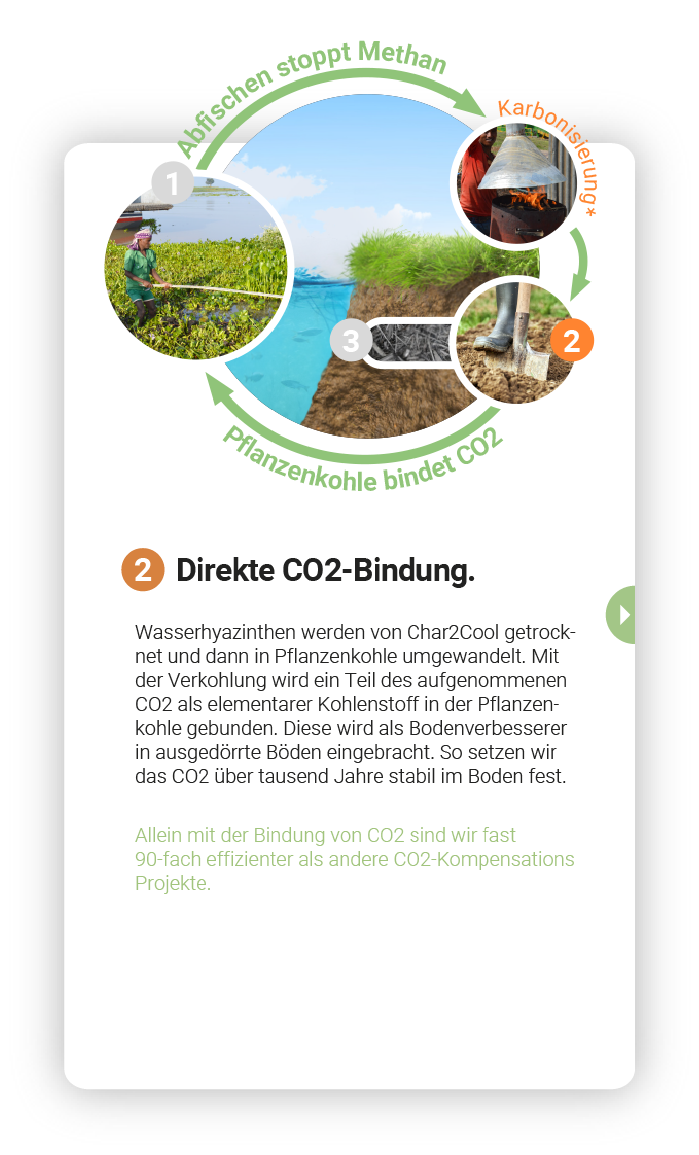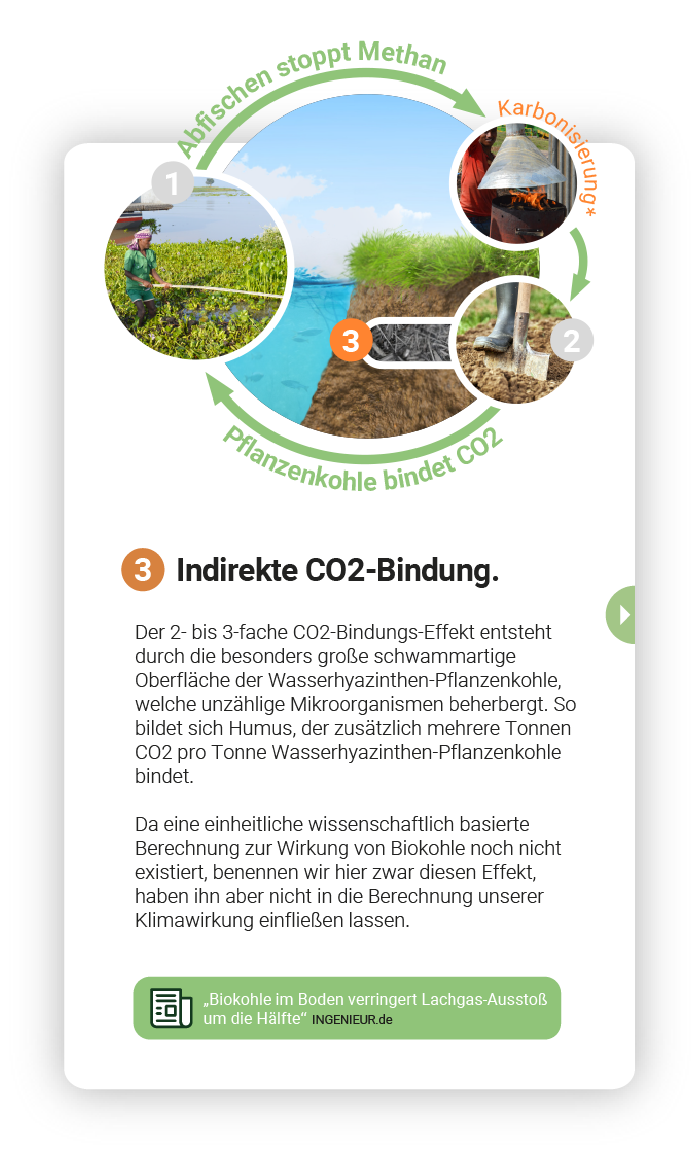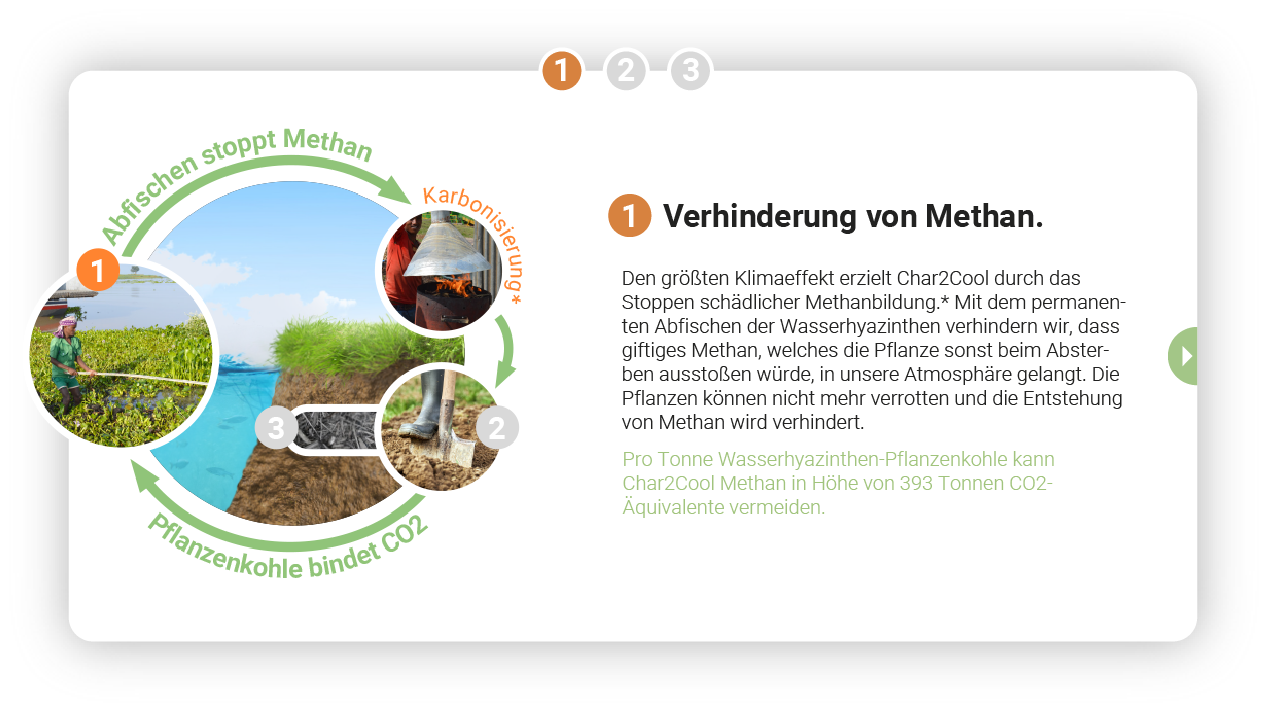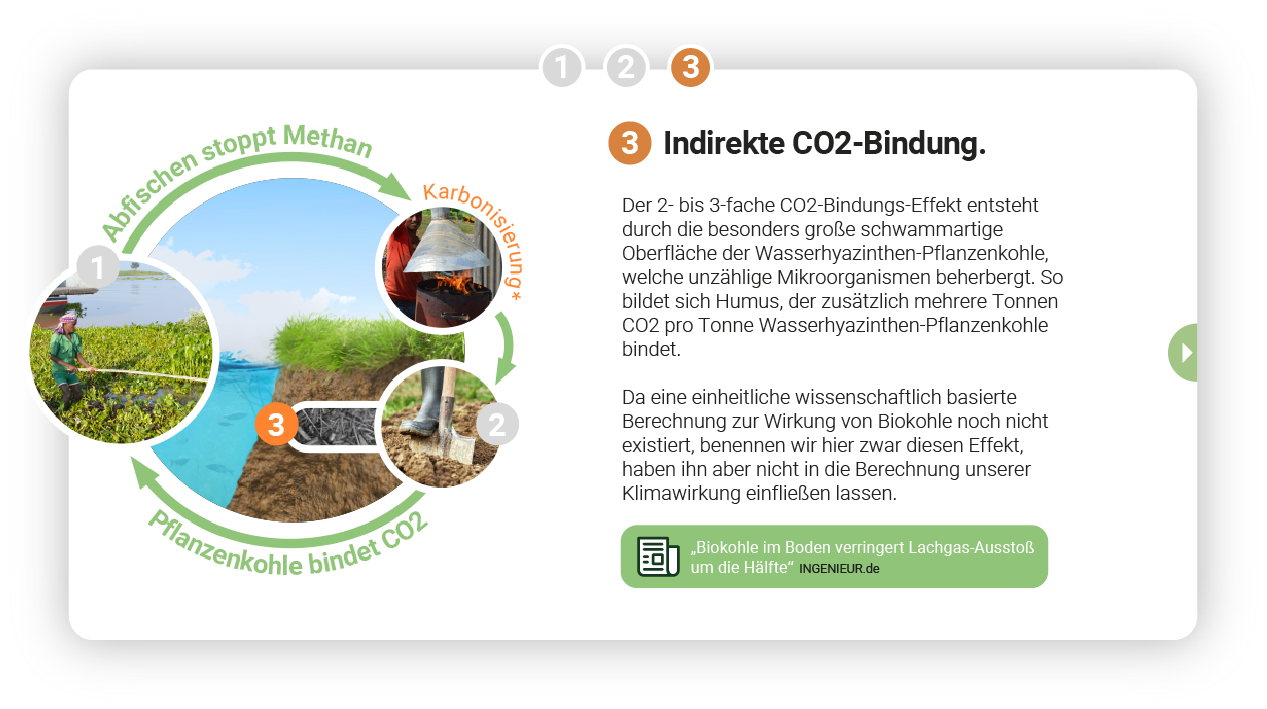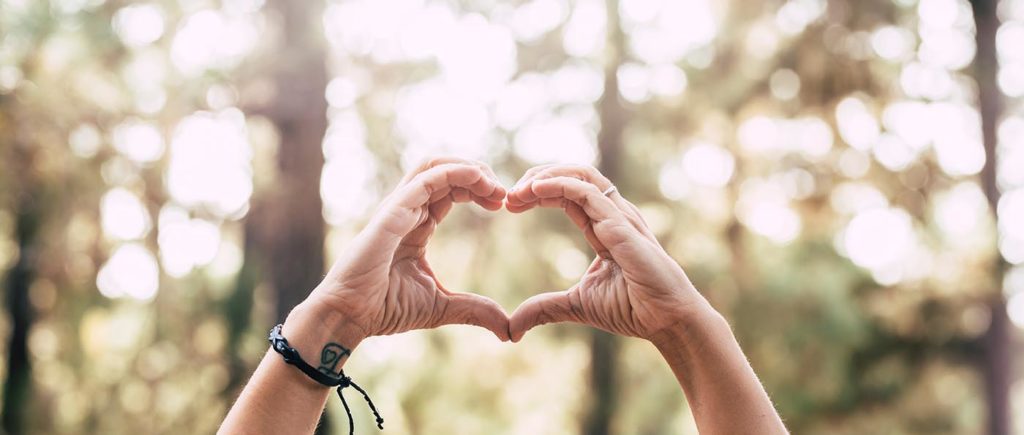"Nothing in the world is as powerful as an idea whose time has come!"
Viktor Hugo
Water hyacinths, a plague
with a devastating climate effect.
When people in Ethiopia look at Lake Tana, they see no water far and wide. What they see, however, is a sea of water hyacinths, which is quite beautiful to look at. The carpet of water hyacinths is over 10,000 hectares in size, an area larger than Berlin. Over a length of more than 84 km, the water hyacinths block access to the lake.
Water Hyacinth Crash Course.
In their original homeland, the Amazon, the water hyacinths are eaten by manatees. In the rest of the world, water hyacinths spread unhindered, because there they lack natural predators. Water hyacinths deprive plants and fish of vital nutrients, paralyze the infrastructure and damage our climate through the emission of methane.
Water hyacinths (Eichhornia)
Water hyacinths are floating aquatic plants that originally come from the Amazon basin in South America. There they are eaten by manatees. Because of their pretty purple flowers, they were introduced as ornamental plants to other tropical areas of Asia and Africa. Here, the natural predators are missing, so that the water hyacinth has been able to spread unhindered and is now overgrowing entire bodies of water worldwide.
Invasive species.
Water hyacinths are probably the fastest growing plant in the world and such an invasive species that the import of water hyacinths is prohibited in many countries, including Germany.
The aquatic plant spreads via cuttings and seeds. As a floating plant, it is collected by the wind and always occurs in masses. Water hyacinths can hardly be eradicated, because their seeds survive for up to 20 years in the mud at the bottom of the waters.
Explosive growth.
With increasing water pollution from wastewater and fertilizers, the water hyacinth has enough nutrients for its explosive growth. Under these conditions, up to 17.5 tons of new water hyacinths grow on one hectare every day, which corresponds to about 1.4 football fields and the weight of 12 cars. As a rule of thumb, you can remember that a water hyacinth population doubles every 2 weeks under optimal conditions.
A problem for the region.
„We used to catch so many fish that we couldn’t carry them on our own. At that time, we loaded our donkeys with sacks full of fish. Now I can only fish when the wind drives away the water hyacinths. My family has only half an acre of land. That’s not enough to live on!”
Mangustu, fisherman from Shea Gomengie
Water hyacinths compete for sunlight and oxygen, depriving plants and fish of vital nutrients. As a result, native aquatic plants, fish and other creatures lack food.
Boats cannot penetrate the water hyacinth carpets and so access to the water is no longer possible. In general, transport over water is almost impossible. The water hyacinths have a fibrous stem that wraps around the ship’s propellers and stalls the engine. In addition, the water hyacinths block harbor basins and other infrastructure in and around lakes.

Largest natural emitter of methane.

The climate-damaging cycle of water hyacinth
Water hyacinths are both a nuisance and a climate killer, when they die within an annual cycle, they sink to the bottom of the water and are decomposed by bacteria. This produces biogas. The biogas, a mixture of methane (CH4) and carbon dioxide (CO2), rises in the water and combines with the air. This is how vast quantities of methane are released into the atmosphere, with devastating effects on our climate.

Methane: 86 times more harmful to the climate than CO2.
Methane is still an underestimated climate killer, but it is increasingly coming into focus due to its climate damage. ‘Researchers recommend rapid reduction of methane emissions’ headlines SPIEGEL Wissenschaft online in April of this year, and goes on to say: ‘If methane emissions were reduced quickly, it could slow down global warming by 30 percent, according to a new study.
The climate impact of the gas is up to 86 times as strong as that of CO2.’
Water hyacinths are the largest natural emitter of methane and thus hold incredible climate protection potential. Char2Cool can avoid methane in the amount of 393 tonnes of CO2 equivalents* per tonne of water hyacinth biochar.
*In science, different gases, including methane, are converted into CO2 equivalents to make the climate impact of the gases comparable.
CHAR2COOL
How to be almost 90 times more efficient.
We protect the climate by converting water hyacinths into biochar. To do this, the plants are fished out of the water, dried and carbonized easily and cheaply in a specially developed shaft furnace, the Char2Cool-Kiln. In doing so, we benefit from a unique climate double effect, which is made up of the avoidance of methane and the binding of CO2.
You can see exactly how this works here.
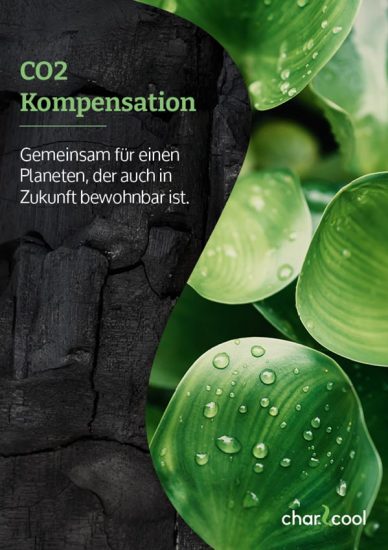
A self-financing system,
that creates prosperity!

Thousands of people in the tropical regions have no regular work. The lack of income leads to a spiral of poverty: no work leads to less education in the next generation and a lack of infrastructure leads to rural exodus.
At Char2Cool, the water hyacinths are harvested, dried and carbonized by hand. Instead of machines, many people are involved in harvesting, drying and charring. The water hyacinths are freely accessible and the work is open to everyone – women, men, young people, the elderly and also people without schooling.
There is a local demand for water hyacinth biochar, because it helps to make depleted soils fertile again. The profitable sale of the water hyacinth biochar creates a self-sustaining system from which everyone benefits: the climate and the local people.

Peter Bassey has been our partner for 15 months in Lagos, Nigeria. During this time, he has already been able to hire 15 employees.
Why hasn't the water hyacinth been harvested everywhere for a long time?
The water hyacinth is now a problem worldwide, if we harvested it, we could quickly cool the climate. So why hasn’t this been done so far?
Why not machines?
For decades, attempts have been made to bring the water hyacinth under control. Every conceivable method of disposal was tried: chemical sprays, harvesting by hand and high-tech harvesting machines – all without lasting success.
At Lake Tana alone, 350 high-tech harvesting machines would be needed to keep pace with the growth of the water hyacinth. Apart from the million-dollar investment for the purchase of the harvesting machines, 3 tanker trucks with diesel would be needed every day to operate the machines.
In addition, space would be needed on the banks to store 100,000 tons of harvested water hyacinths every day. This makes no ecological sense and is impossible in practice!
… and if only a single water hyacinth or seed remains in the river or lake when it is removed, the water hyacinth spreads again very quickly.
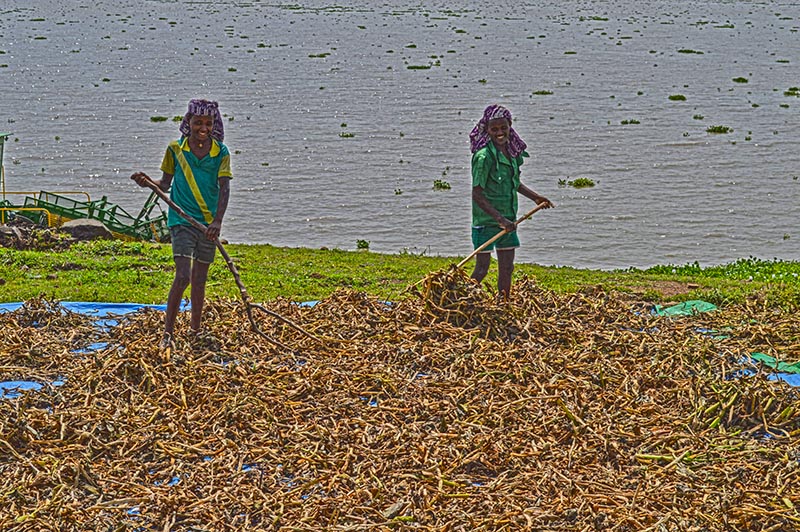
What do we do differently?
At Char2Cool, we don’t see water hyacinth as a nuisance, but as the largest and cheapest biomass source in the world, from which we can generate water hyacinth biochar for the region. The difference? A profitable product that makes annual fishing useful instead of tedious.
There is a local demand for water hyacinth biochar, because it helps to make depleted soils fertile again. The profitable sale of the water hyacinth biochar creates a self-sustaining system. In this way, a plague becomes an opportunity for climate protection, poverty reduction and sustainable development.
Why hasn't this been done for a long time?
Research on this topic has been going on for over 20 years, and there are some small projects worldwide that are running successfully.
What has been missing for long-term success so far have been sustainable and profitable water hyacinth products for which there is local demand and which thus make annual harvesting economically viable. This is where Char2Cool comes in. We create products that are relevant locally and strengthen local demand.
Our products are:
1) Water hyacinth biochar: With the development of the Char2Cool-Kiln, we have already perfected the production of water hyacinth biochar. We are currently working on strengthening local demand. You can find out more about this here.
2) Water hyacinth briquettes as a substitute for charcoal and firewood:So far, our water hyacinth briquettes do not burn well enough because they absorb so many nutrients in the water. But we are already working on the solution.
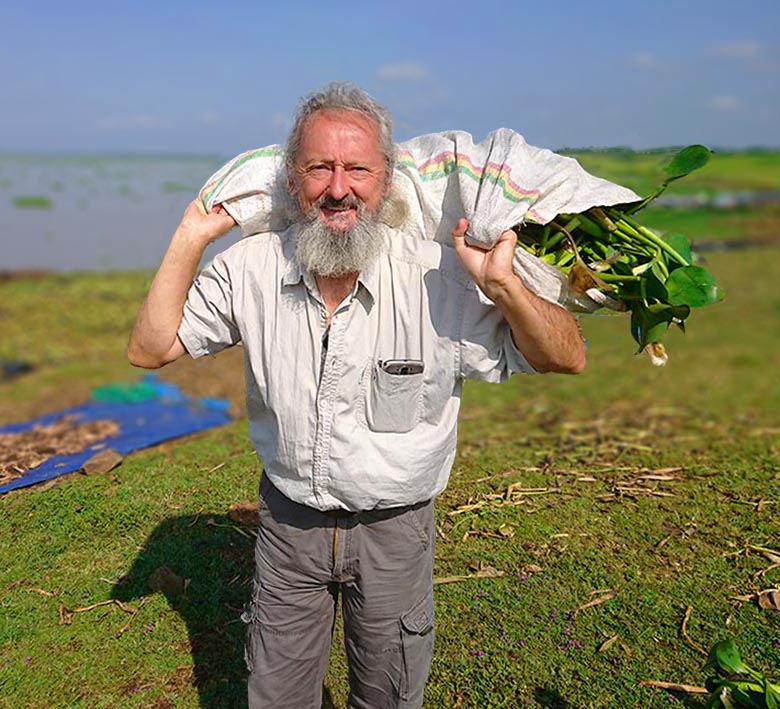
Still unsure?
This project is close to our hearts and we critically question ourselves and our actions and you can do that at any time. In our Reisbach office, or wherever we are at the moment, we are available and ready for dialogue, because our joint action should not fail because of open questions in your head.
Feel free to contact Walter directly at wd@char2cool.de. Otherwise, we have already answered one or the other question in our FAQ’s.


